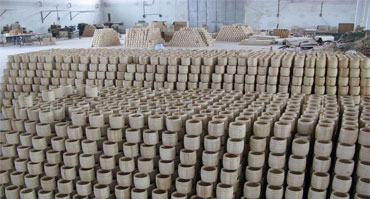
1. The drying process of handicrafts
The drying technology of ceramic handicrafts generally adopts hot air drying technology. The energy sources include natural gas combustion, coal combustion and electric furnace. However, the long drying cycle results in slow capital turnover and poor uniformity, and ceramic drying kilns account for Large area and high energy consumption. The hot-air rapid drying means that the drying atmosphere changes according to the body and the dryness of the body, keeping the best drying atmosphere at all times and increasing the drying speed. The rapid drying room with automatic temperature and humidity adjustment has the following characteristics:
①Small space, fast response and high accuracy during parameter adjustment;
②Different drying curves can be set according to the condition of the green body;
③Industrial computer control, high degree of automation, reducing the factors of human error, and high rate of qualified drying of the green body. This system consists of six parts: room structure, hot blast stove, air distribution system, mixing system, control system and humidity system.
The moisture content of the ceramic body is generally between 5% and 25%. The body moisture is composed of equilibrium moisture and free moisture. In a certain air state, the limit of drying is to make the body reach equilibrium moisture. Equilibrium water is a part of bound water, and its amount depends on the temperature and relative humidity of the drying medium. When the bound water is discharged, the volume of the green body does not shrink, which is relatively safe.
In the case of stable drying conditions, there is a certain relationship between the surface temperature, moisture content, drying rate and time of the green body. According to the change characteristics of the relationship between them, the drying process can be divided into: heating stage, constant drying stage, reduction Three processes in the rapid drying stage:
1. Heating stage
Since the heat transferred by the drying medium to the surface of the body in a unit time is greater than the heat consumed by the evaporation of the surface moisture, the temperature of the heated surface gradually increases until it equals the wet bulb temperature of the drying medium. At this time, the surface gains heat and the evaporation heat consumption reaches Dynamic equilibrium, the temperature does not change. At this stage, the moisture content of the green body decreases and the drying rate increases.
2. Isokinetic drying stage
The discharge of unbound water continues at this stage. Due to the high moisture content of the body, how much water is evaporated on the surface, how much water can be supplemented inside, that is, the water movement speed (internal diffusion speed) inside the body is equal to the surface water evaporation speed and the external diffusion speed, so the surface maintains a moist state . At the end of the isokinetic drying stage, the moisture content of the material is reduced to a critical value. At this time, although the inside of the material is still unbound water, bound water begins to appear in the surface layer.
3. Deceleration drying stage
In this stage, the water content of the green body decreases, the internal diffusion speed cannot keep up with the surface water evaporation speed and the external diffusion speed, the surface no longer maintains moisture, and the drying rate gradually decreases. As the heat required to evaporate the surface water is reduced, the temperature of the material starts to rise gradually. The partial pressure of water vapor on the surface of the material is less than the partial pressure of saturated water vapor at the surface temperature. At this stage, the bound water is discharged, the body does not shrink in volume, and does not produce dry waste. When the water content of the material drops to equal to the equilibrium moisture, the drying rate becomes zero and the drying process is terminated.

Second, the advantages of the Nystar drying and dehumidifier drying solution
(1) The fully automatic control system can select the best drying temperature and humidity according to the process requirements of different products, which completely solves the problems of long drying time, high temperature, and high energy consumption in other drying methods. It is unparalleled Table more features.
(2) The use of high-efficiency centrifugal fans has the characteristics of strong wind, uniform air flow, low noise, etc., and the materials are dried evenly and quickly.
(3) During the drying process, the material will not be deformed, cracked, discolored, degraded, not oxidized, thoroughly dried, rehydrated after drying, less nutrient loss, long storage period, and more effectively protects the color and fragrance of the dried material. , Flavor, shape and active ingredients.
(4) The integrated design of the unit can be used when the pipeline and power supply are connected on site; the operation is convenient, after setting the parameters, the automatic control can be realized, and the reliability is high.
(5) Low investment and quick results. Old kilns, garages, etc. can be used for transformation, and it can be moved and save floor space. It is simple and convenient.
Previous : 没有了!
Next : Paper tube drying solution


Mobile phone:13929191085 13422006435
E-mail:835727061@qq.com QQ:835727061
Address Factory:No. 28, Beihu 1st Road, Luocun, Shishan Town, Nanhai District, Foshan City